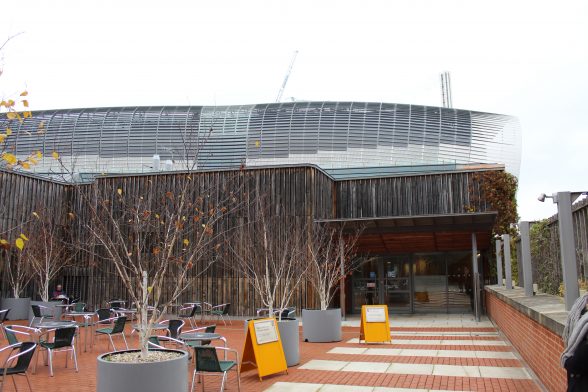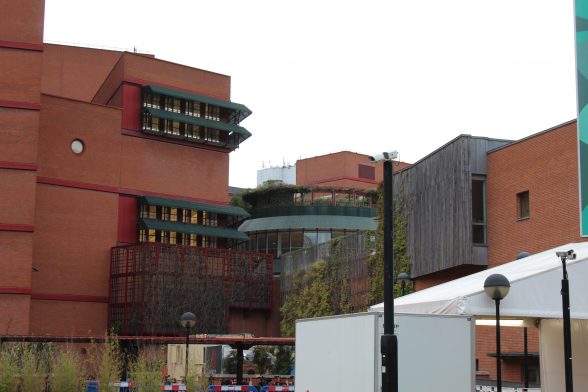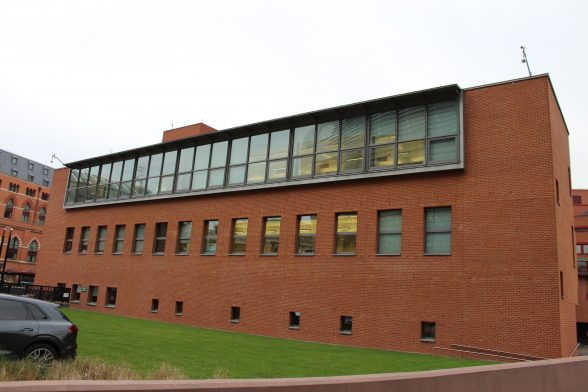This website uses cookies
This website uses cookies to enable it to function properly and to analyse how the website is used. Please click 'Close' to accept and continue using the website.



The Twentieth Century Society is concerned by plans to demolish the British Library Centre for Conservation which have moved a step closer with an application for a Certificate of Immunity, which would prevent the building from being listed for five years. The building was constructed just 14 years ago at a cost of £13 million.
C20 Society Caseworker Coco Whittaker said: “We believe the Centre for Conservation is an integral part of the Grade I listed British Library. It is not only physically connected with it, and accessed through it, but is strongly associated with it in its architectural form, function and authorship. The same architects who worked on the British Library created the Centre for Conservation to be a respectful and complementary later addition, housing state-of-the-art conservation and recording facilities.
“For these reasons, we urge Historic England to reject the application for a Certificate of Immunity and to review the listing of the British Library to include the Centre for Conservation.”

The whole site is subject to a complex set of plans, which include an extension to the British Library and the creation of new east-west links to the rear of the library as well as infrastructure for Crossrail 2. The COI application has been submitted by the contractors for the British Library, SMBL Developments Ltd, a consortium comprising Stanhope plc and Mitsui Fudosan UK Ltd, working with architects Rogers Stirk Harbour + Partners (RSHP) and engineers Arup. C20 is awaiting details of the SMBL’s plans which have not yet been submitted.
The British Library was built between 1982 and 1999 by Sir Colin St John (‘Sandy’) Wilson and M.J. Long, amongst others. The BL was Grade I listed in 2015 and reasons for designation included its architectural interest, with “its stately yet accessible modernist design rooted in the English Free tradition with Arts and Crafts and classical influences, crisply and eloquently contextualised by its massing and use of materials”; its historic interest as “a landmark public building”; and its significance as “a major work by the eminent architect and academic Sir Colin St John Wilson and his architectural partner, M.J. Long”. The empty land to the north of the library was always intended for future extensions.

The BLCC was built as a northern extension, designed in 2003-5 and erected in 2005-7 by M. J. Long & Rolfe Kentish and the consultant Colin St John Wilson with engineering by Arup and Sir Robert McAlpine as lead contractor. It was built to provide a world class facility for all aspects of book conservation including education and training and to house state-of-the art technical facilities for the National Sound Archive. It brought together for the very first time all of the library’s conservation staff. It was carefully planned and equipped to accommodate these specialist functions.

While it was important that the BLCC had its own architectural identity, it also needed to be subservient to the BL. It is L-shaped, steel-framed building faced with red brick—matching that on the BL but subtly different in its flush rather than recessed pointing—with oak cladding and trellises, metal-framed windows and a glazed ‘saw-tooth’ roof. The building was well-reviewed in the Architects’ Journal in 2007. This article admired the contrast between the “big, bold and rhetorical” forms of the BL and its “strangely mute and humble, almost primitive” extension. The BLCC is connected to the BL via a specially-built public terrace (playfully called “the acropolis”) at first floor level and by way of a covered corridor at the lower level.
The British Library’s listing excludes the British Centre for Conservation under the Enterprise and Regulatory Reform Act (ERRA) (2013). The list entry states that, “The Conservation Centre: although attached to the rear north elevation […] is a separate building and very recent in date. It is not part of the special interest of the Library.” When the BL was listed in 2015, the BLCC was then only 8 years old and this influenced the decision to exclude it from the listing.
The building was featured in C20’s Top 10 Buildings at Risk List 2019.

Become a C20 member today and help save our modern design heritage.